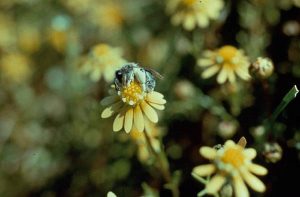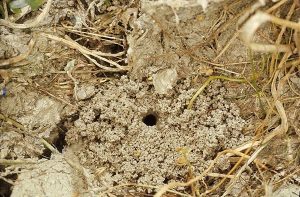Vernal pools are noted for their multicolored rings and ribbons of native flowers. Each species occupies a different topographic position and microhabitat within the pool. And each produces an abundant and dense display of flowers which all bloom at the same time.

Besides delighting the eye of human visitors, there is an important ecological reason for the flowers of a given species to bloom in mass synchrony. Many of the showiest vernal pool flowers (Yellow Carpet, Meadowfoam, Goldfields, and Downingia) are pollinated by native specialist bees in the family Andrenidae. These solitary, ground-nesting bees use the pollen of specific flowers to feed their young. And, during the course of collecting pollen to provision their nests, they perform the vital function of cross-pollinating the vernal pool flowers.
Each of the four plant groups listed above has one or more native specialist bees that collects pollen only from them. The life cycle of these bees is closely synchronized with that of their pollen host flowers. While generalist and non-native bees, such as the honey bee, and other insects also visit most of these flowers and may potentially pollinate them, research shows that at least some of these flowers may require their specialist pollinators for successful reproduction and seed set.

Life Cycle of Native Specialist Bees
Female bees in the family Andrenidae, which specialize on pollen of vernal pool flowers, are on the wing only in early spring when their host plants are in flower. The life cycle of the bee is closely tuned to that of its host plant’s bloom period. The bees emerge at or just before their host flowers start to bloom. The female bees construct nests in the soil of the upland areas surrounding vernal pools.
The basic nest architecture consists of a vertical shaft penetrating the soil for a few inches before becoming a lateral tunnel ending in a single brood chamber. When brood chamber construction is complete, the female bee forages for pollen on her preferred host flowers. The pollen (with a little nectar) is rolled into a ball, and then she lays a single egg on top. She then constructs a plug closing off the entrance to the chamber.
The female will then begin another lateral shaft to a new brood chamber. The lateral shafts are arranged at the bottom of the vertical shaft much like spokes of a wheel.



After a few weeks, the egg hatches and the larva begins feeding on the pollen and nectar provisions. After consuming all of the pollen ball in the spring, the larva rests in its chamber for the remainder of the summer. In the fall, the larva pupates and transforms into an adult. The adult sits in the brood chamber until the following spring, when it emerges to continue its life cycle in association with the flowering of its pollen host plant.
The majority of the life cycle of these bees is spent in the brood cell. Overwintering as an adult is an adaptation to synchronize the bees with the early spring bloom of their pollen host plants. During droughts, the adults may remain underground for more than a year or two.

